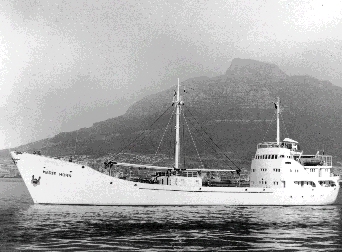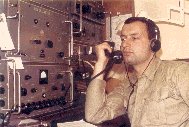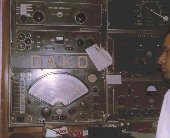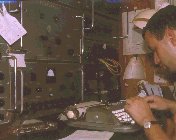M/S "Marie Horn"

M/S Marie Horn, call sign
DAKO, 1.137 GRT, ship yard: Sietas Hamburg, in service 02/19/59.
1969 sold as "Deep Freeze"
to Monrovia, 1971 to Panama. 1976 after explosion and fire in engine room
sunk near Miami. Now an official "artificial reef," to provide a fish-friendly
environment.
Seafaring time: 11/22/65
- 09/19/66
|
I began my seafaring career
on the "Marie Horn". The shipping firm was "Heinrich C. Horn," a subsidiary
of "Hamburg-Süd." Many radio newcomers began their seafaring careers
on Horn ships. The management must, by the way, also arrange for radio
operators to help run the ship, which was my responsibility. With
the 18 man crew I had no large problems, though this was not particularly
my favorite job. Though the ship was built in 1956, it had no Radar,
no automatic steering, no VHF radio, and naturally there was no air-conditioning
for the crew quarters - and the cargo space could go down to -21°C.
(-4°F) The Marie Horn was a small refrigerated ship in coastal motorship
form, and ran, in my time, between Capetown and Walvis Bay, and Spanish
ports, mostly Cadiz.
The Radio Station
Manufacturing Organization:
DEBEG (Deutsche Betriebsgesellschaft für drahtlose Telegrafie) (German
Manufacturer for Wireless Telegraph) Short-wave transmitter: Lorenz S540
(200 Watts output. Frequency range 4 to 16 Mhz.)
Medium-wave transmitter:
Telefunken 527 (70 Watts output) combined for main power and emergency
power.
Main receiver: Siemens E566
(Standard receiver from the '50's to the end of the '60's on German ships.)
Emergency receiver: Siemens
E-500.
The radio room actually had a strong resemblance to the radio cubicle
on an old German U-Boat.

Center
the power supply. Over it the medium wave transmitter S527 |
|
The upbeat time ended November
1965 when an outrun from Cadiz was not very promising; seasick, then the
main receiver failed and could not be repaired with the materials on board,
and I had collected a whole pile of Christmas telegrams. I had absolutely
no desire to call Cadiz Radio/EAC with the 500 kc transmitter, so I switched
to hf, and bathed in sweat, with a damp hand called Norddeich Radio; Normally
I would hear them and switch to an alternate frequency. Actually
no problem, but the main receiver was not working, and the emergency receiver
did not have good calibration for hf, and I had to keep my hand on the
tuning knob the whole time to try to find the correct frequency.
I directly came to Norddeich Radio, and copied, "DAKO DE DAN QSA 0 ND PSE QSR
SK." (I cannot copy you. Please send your call again.) |
Picture this misery: One
hand on the receiver, one hand on the telegraph key, and a bucket between
my legs, while I was sick and the small ship strongly rolled in the heavy
seas. The next call was successful, and I told Norddeich that I was a newcomer
and
had receiver trouble.
That worked, and the operator on the other end had patience and made a
great effort to work me. He permitted the combination of my approximately
ten telegrams without the word count, and I was greatly relieved.
After a week, everything
was different. Seasickness was gone, in Dakar harbor I found the
replacement part for the main receiver, and I could again do normal radio
operation. About 14 days later we were in Kapstadt, this wonderful
city.

Bottom
left the main receiver Siemens E566, over it the coastal telephony transmitter
Lorenz S509 |
|
In the 10 months on the
Marie Horn I had my intensive maritime radio experience. Because
of the relatively weak performance of the transmitter, without 22 Mhz,
and the long distances, one quickly develops a feeling for propagation
conditions, traffic time, and the right frequency. It was always
easy to work both coastal stations, Norddeich Radio and Cape Town Radio,
and one could depend on them.
In September our charter
ended, and we took our last fish load to
Bremerhaven.
In the Bay of Biscay and
the English Canal I experienced heavy traffic density for the first time
on the 500 Khz emergency and calling frequency. Hell was loose on 500 Khz!
The discipline of the ships and coastal stations in handling traffic was
impressive.
In Bremerhaven I left the
ship, as it was converted to a "Telephone Ship."
Later I learned that the
Marie Horn was sold in Panama in 1969. After suffering an explosion
and fire in the engine room in 1974 while in the port of Limon, it was
removed from service. Today this fine little ship lies on the sea
floor off Miami, sunken as an official "artificial reef," to provide a
fish-friendly environment. |

Bottom
left the emergency receiver Siemens E500, right over it the short wave
transmitter Lorenz S540, without 22 Mhz ! |



